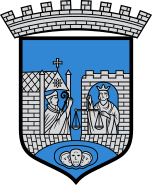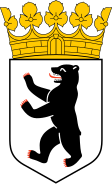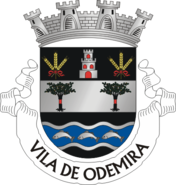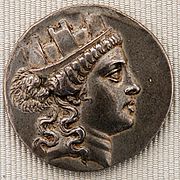
Mural crown on Cybele (silver tetradrachm issued by Smyrna, 160–150 BC)
A mural crown (Latin corona muralis) is a crown or headpiece representing city walls or towers. In classical antiquity, it was an emblem of tutelary deities who watched over a city, and among the Romans a military decoration. Later the mural crown developed into a symbol of European heraldry.
Usage in ancient times[]
In Hellenistic culture, a mural crown identified the goddess Tyche, the embodiment of the fortune of a city, familiar to Romans as Fortuna. The high cylindrical polos of Cybele too could be rendered as a mural crown in Hellenistic times, specifically designating the Mother Goddess as patron of a city.[1]
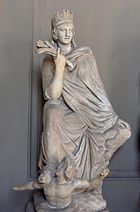
The Tyche of Antioch, Roman version of a 3rd-century BC bronze by Eutychides
The mural crown became an ancient Roman military decoration. The corona muralis (Latin: "walled crown") was a golden crown, or a circle of gold intended to resemble a battlement, bestowed upon the soldier who first climbed the wall of a besieged city or fortress to successfully place the standard of the attacking army upon it.[2] The Roman mural crown was made of gold, and decorated with turrets,[3] as is the heraldic version. As it was among the highest order of military decorations, it was not awarded to a claimant until after a strict investigation.[4] The rostrata mural crown, composed of the rostra indicative of captured ships, was assigned as naval prize to the first in a boarding party, similar to the naval crown.
The Graeco-Roman goddess Roma's attributes on Greek coinage usually include her mural crown, signifying Rome's status as a loyal protector of Hellenic city-states.[5]
Heraldry[]
The Roman military decoration came to be employed in European heraldry, where the term is used to denote a crown modeled after the walls of a castle, which may be tinctured or, argent, gules, or proper, i.e. stone-coloured. In Germany, during the 19th century mural crowns (Mauerkronen) came to be adopted for the arms of cities, with increasingly specific details: "Residential (i.e. having a royal residence) cities and capital towns usually bear a Mauerkrone with five towers, large towns one with four towers, smaller towns one with three", observed Arthur Charles Fox-Davies, in A Complete Guide to Heraldry, adding "Strict regulations in the matter do not yet exist" and warning that the usage was not British.[6]

Modern elaborations of mural crowns of Catalan heraldry, without historic usage
In recent times,[when?] mural crowns used, rather than royal crowns, for Italian medieval and modern communes. A mural-crowned lady, Italia Turrita, is a symbol of Italy. In Italy, communes and some provinces and military corps have a mural crown on their coat of arms, golden and with five towers for cities, silver and nine-towered for the others; also use it. The coat of arms of the Second Spanish Republic had a mural crown.
In the beginning of the 20th century, Portugal established strict rules for its municipal heraldry in which, each coat of arms contains a mural crown, with three apparent silver towers signifying a village or an urban parish, four silver towers representing a town, five silver towers standing for a city and five gold towers for a capital city. The mentioned Portuguese rules regarding the use of mural crowns are also applied in most of the municipal coat of arms of Brazil and some other members of the Community of Portuguese Language Countries.
The Romanian municipal coats of arms contain a mural crown, with one or three towers for villages and communes, five and seven towers for towns and municipalities.
After the dissolution of the Austro-Hungarian Empire at the end of World War I, the single-headed eagle of the coat of arms of Republic of Austria began to wear a mural crown in the place of the former royal Austrian and Hungarian crowns that adorned the double-headed eagle of former coat of arms.
Examples from heraldry[]
See also[]
| Wikimedia Commons has media related to Mural crowns. |
- Naval crown
- Grass Crown
- Civic Crown
- Emblem of Italy
- Laurel wreath
- Italia Turrita
- National personification
- The Stella d’Italia
References[]
- ↑ The mural crown as an indicator of the personification of a city was thoroughly explored by: Allègre, Fernand (1889) (in French). Étude sur la déesse grecque Tyché. Paris. pp. 187–92. http://www.archive.org/details/tudesurlades00alluoft.
- ↑ Aulus Gellius, Noctes Attici, V.6.4; Livy, Ab Urbe Condita, XXVI.48
- ↑ muri pinnis according to Aulus Gellius
- ↑ Livy. l.c.; cf. Suetonius, Lives of the Twelve Caesars, Augustus 25.
- ↑ Mellor, R., "The Goddess Roma" in Haase, W., Temporini, H., (eds), Aufstieg und Niedergang der romischen Welt, de Gruyter, 1991, pp 60-63.
- ↑ William Newton, Display of Heraldry (1846, p. 307) however, instances the crest of Viscount Beresford, and notes examples supporting the crest "to be seen over the arms of many of the British officers who distinguished themselves in the late war".
External links[]
The original article can be found at Mural crown and the edit history here.

